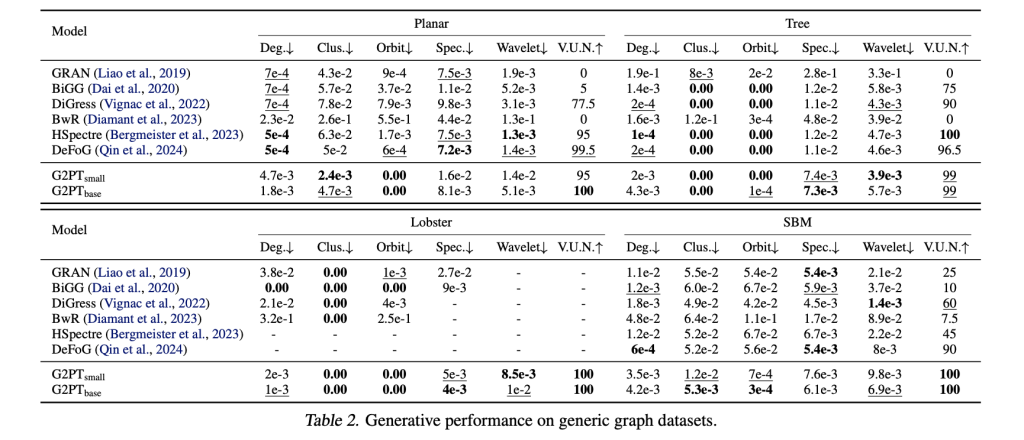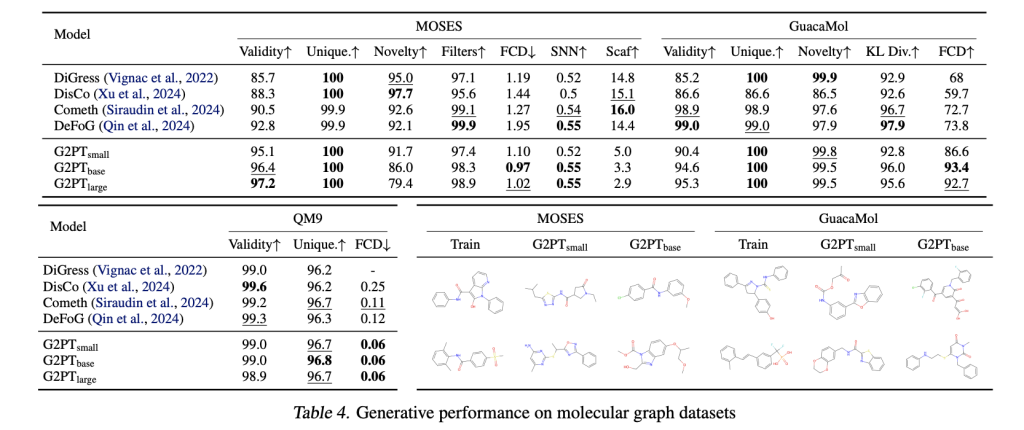Graph generation is an important task in several fields, including molecular design and social network analysis, due to its ability to model complex relationships and structured data. Despite recent advances, many generative graph models still rely heavily on adjacency matrix representations. While effective, these methods can be computationally demanding and often lack flexibility. This can make it difficult to efficiently capture the intricate dependencies between nodes and edges, especially for large, sparse graphs. Current approaches, including autoregressive and diffusion-based models, face challenges in scalability and accuracy, highlighting the need for more refined solutions.
Researchers at Tufts University, Northeastern University, and Cornell University have developed the Generative Graph Pretrained Transformer (G2PT), an autoregressive model designed to learn graph structures by predicting the next token. Unlike traditional methods, G2PT uses a sequence-based graph representation, encoding nodes and edges as sequences of tokens. This approach streamlines the modeling process, making it more efficient and scalable. By leveraging a transformative decoder for token prediction, G2PT generates graphs that maintain structural integrity and flexibility. Additionally, G2PT adapts to downstream tasks such as goal-oriented graph generation and graph property prediction, making it a versatile tool for various applications.
Technical information and benefits
G2PT introduces a sequence-based representation that divides graphs into node and edge definitions. Node definitions detail indexes and types, while edge definitions describe connections and labels. This approach moves away from adjacency matrix representations by focusing only on existing edges, reducing sparsity and computational complexity. The transformer decoder effectively models these sequences by predicting the next token, which offers several advantages:
- Efficiency: By addressing only existing edges, G2PT minimizes computational overhead.
- Scalability: The architecture is suitable for handling large and complex graphs.
- Adaptability: G2PT can be tuned for a variety of tasks, improving its utility in domains such as molecular design and social network analysis.
The researchers also explored tuning methods for tasks such as goal-oriented generation and graph property prediction, expanding the model's applicability.
Experimental results and insights
G2PT has demonstrated strong performance on various data sets and tasks. In overall graph generation, it matched or exceeded the performance of existing models on seven data sets. In generating molecular graphs, G2PT showed high validity and uniqueness scores, reflecting its ability to accurately capture structural details. For example, on the MOSES dataset, G2PTbase achieved a validity score of 96.4% and a uniqueness score of 100%.
In a goal-oriented generation, G2PT aligned the generated graphs with the desired properties using tuning techniques such as rejection sampling and reinforcement learning. These methods allowed the model to adapt its results effectively. Similarly, in predictive tasks, G2PT additions yielded competitive results across all molecular property benchmarks, reinforcing its suitability for generative and predictive tasks.


Conclusion
The Graph Generative Pretrained Transformer (G2PT) represents a significant step forward in graph generation. By employing sequence-based representation and transformer-based modeling, G2PT addresses many limitations of traditional approaches. Its combination of efficiency, scalability and adaptability makes it a valuable resource for researchers and practitioners. While G2PT shows sensitivity to graph ordering, further exploration of universal and expressive edge ordering mechanisms could improve its robustness. G2PT exemplifies how innovative representations and modeling approaches can advance the field of graphics generation.
Verify he Paper. All credit for this research goes to the researchers of this project. Also, don't forget to follow us on <a target="_blank" href="https://twitter.com/Marktechpost”>twitter and join our Telegram channel and LinkedIn Grabove. Don't forget to join our SubReddit over 60,000 ml.
UPCOMING FREE ai WEBINAR (JANUARY 15, 2025): <a target="_blank" href="https://info.gretel.ai/boost-llm-accuracy-with-sd-and-evaluation-intelligence?utm_source=marktechpost&utm_medium=newsletter&utm_campaign=202501_gretel_galileo_webinar”>Increase LLM Accuracy with Synthetic Data and Assessment Intelligence–<a target="_blank" href="https://info.gretel.ai/boost-llm-accuracy-with-sd-and-evaluation-intelligence?utm_source=marktechpost&utm_medium=newsletter&utm_campaign=202501_gretel_galileo_webinar”>Join this webinar to learn practical information to improve LLM model performance and accuracy while protecting data privacy..
Asif Razzaq is the CEO of Marktechpost Media Inc.. As a visionary entrepreneur and engineer, Asif is committed to harnessing the potential of artificial intelligence for social good. Their most recent endeavor is the launch of an ai media platform, Marktechpost, which stands out for its in-depth coverage of machine learning and deep learning news that is technically sound and easily understandable to a wide audience. The platform has more than 2 million monthly visits, which illustrates its popularity among the public.
<script async src="//platform.twitter.com/widgets.js” charset=”utf-8″>
 NEWSLETTER
NEWSLETTER





